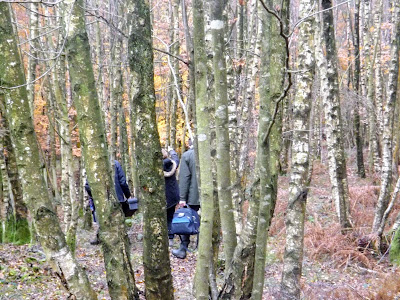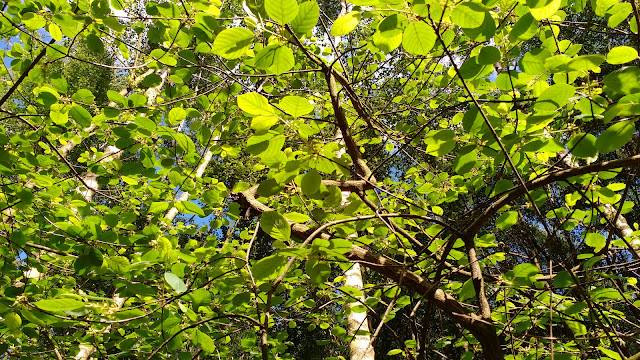 |
| Winter late afternoon at Old Copse |
This is what we did in 2017, or aim to complete by March 2018: (OC1 is the southern 15 acres, OC2 is the northern 15 acres.)
- Finished broad-leaf tree planting in the OC2 thinned scots pine plantation.
- Finished 'halo' thinning around existing broadleaf trees in the OC2 birchwood.
- Woodland edge hazel planting along the bluebell track which runs S/N and E/W through the OC2 birchwood. Scheduled for Jan/Feb .
- Finished holly thinning in OC2. but after review decided there is a further small amount of selective thinning/pollarding to do. Scheduled for Jan/Feb/March.
- Finished planting a mixed hedge along our border (OC1 / OC2) with the road. After review, we decided to order an additional 100 hedging plants to fill in a few remaining gaps. Scheduled for Jan/Feb 2018
 |
| Some of last season's broad leaf planting in the pines |
In addition, essential routine work throughout the year - in no particular order :
- Creating and maintaining paths, tracks, rides, scallops, glades and grassy habitat.
- Pollarding the south half of the willow shoots in the OC1 willow grove, together with a small amount of birch removal .
- Involving neighbouring land owners in deer management plans.
- Applying for funding for general management and specific projects
- Monitoring and reducing the grey squirrel population.
- Protecting and/or transplanting regenerating broadleaf trees, shrubs and ground flora.
- Managing the spread of bracken and bramble.
- Processing firewood.
- Cabin maintenance and improvements .
- Ride and track drainage.
- Checking boundaries and collecting roadside litter
Lastly, and importantly, making time to enjoy the wood, its wildlife and visitors.
2017 has seen the completion of our biggest projects - the big plant following the big thin. The wood has largely recovered from the onslaught of large machinery: grass has grown over the tide of mud on the ride and the scars and tracks have settled down and are barely visible. In 2018 the work will be maintaining what we have achieved, monitoring our new trees as they (hopefully) grow beyond their tubes, and looking after our newly planted roadside hedge during its first season.
 |
| 'Little House in the Big Woods' |
HAPPY NEW YEAR

















































